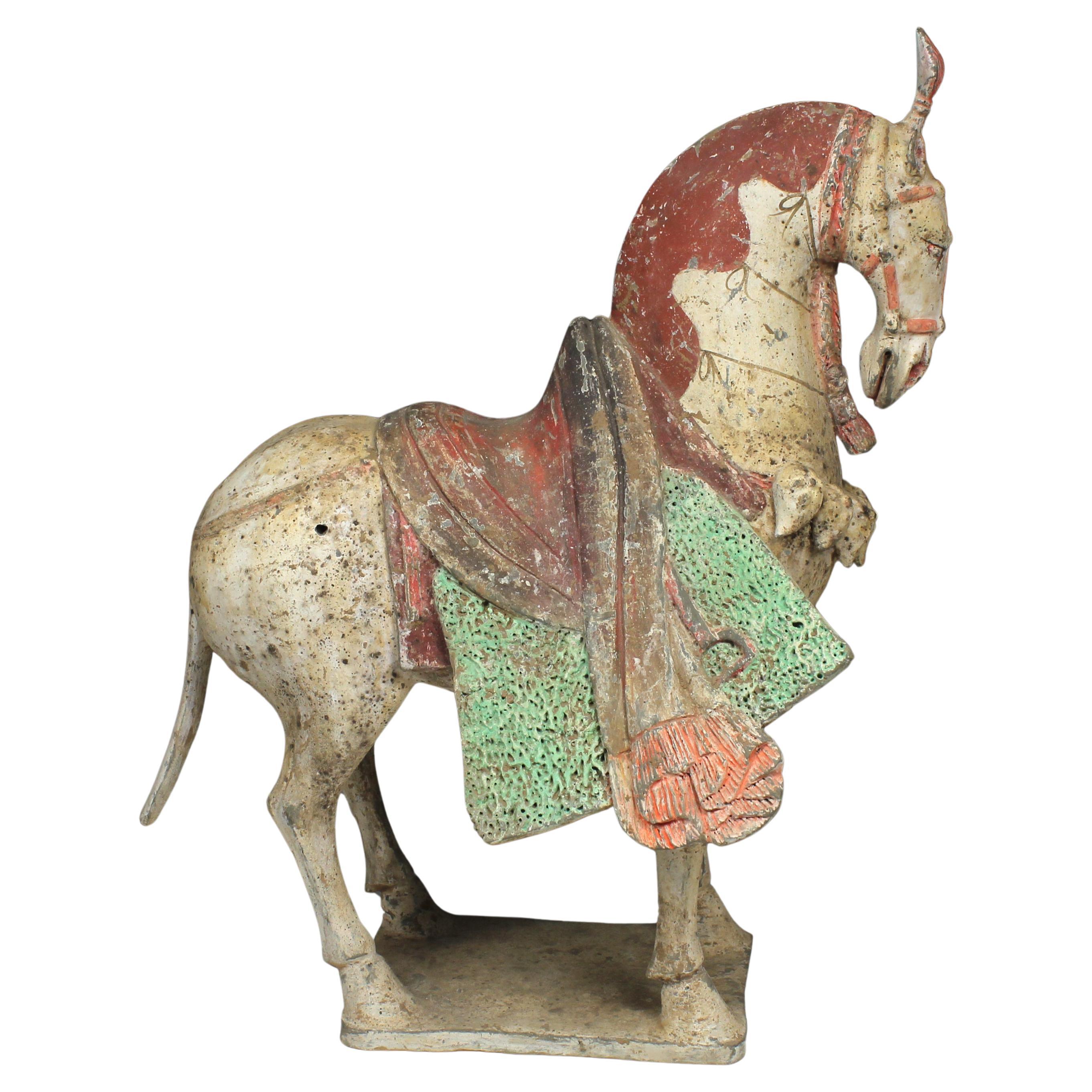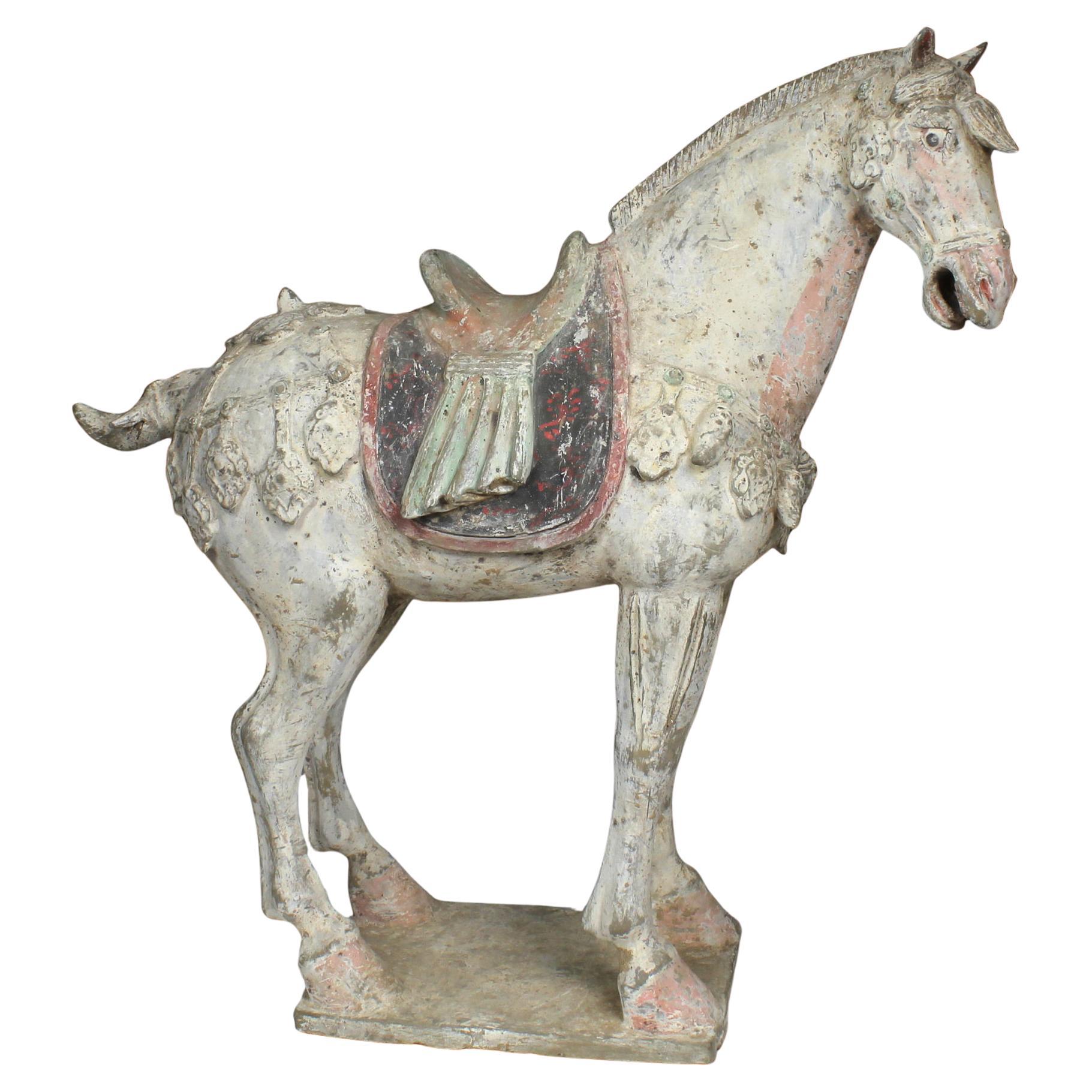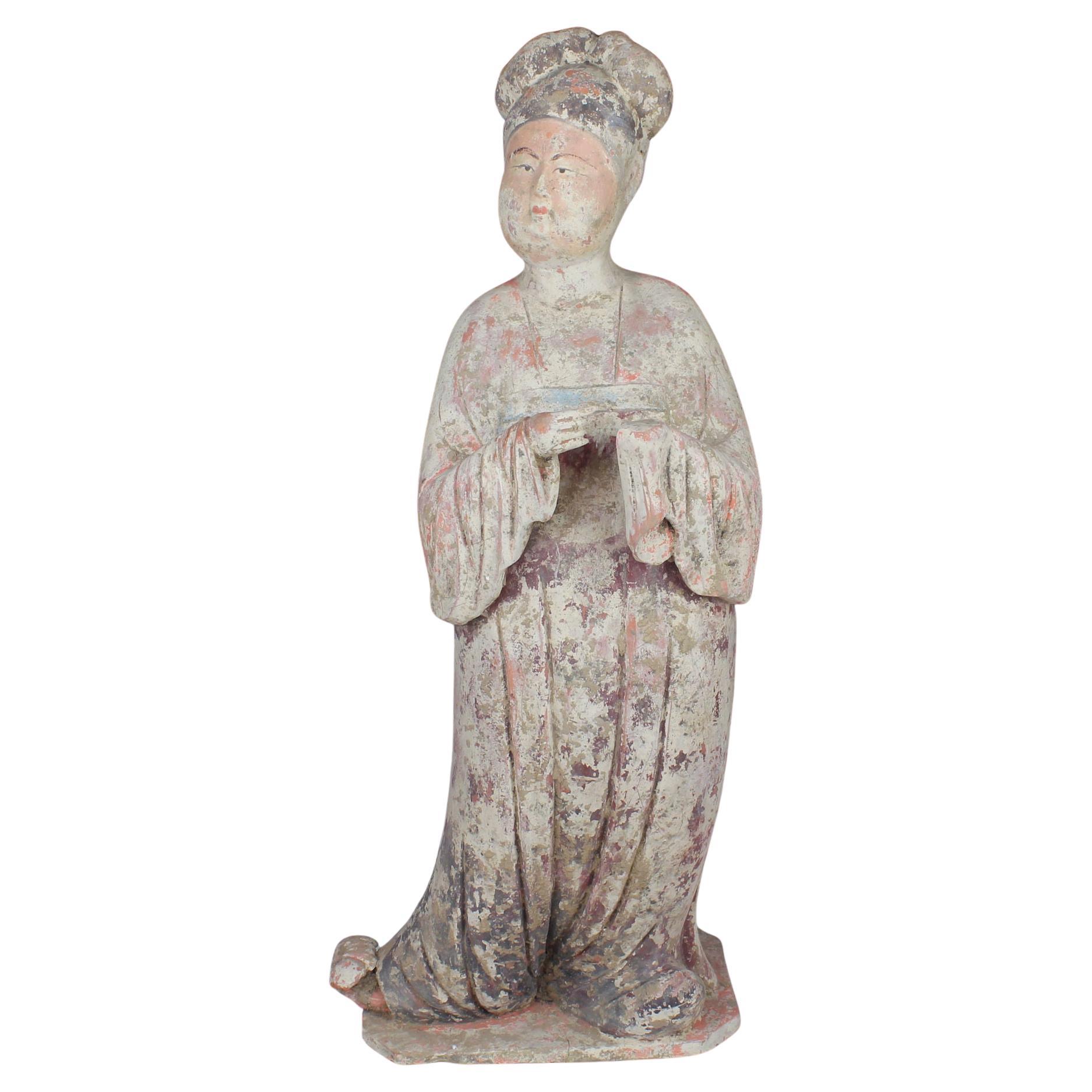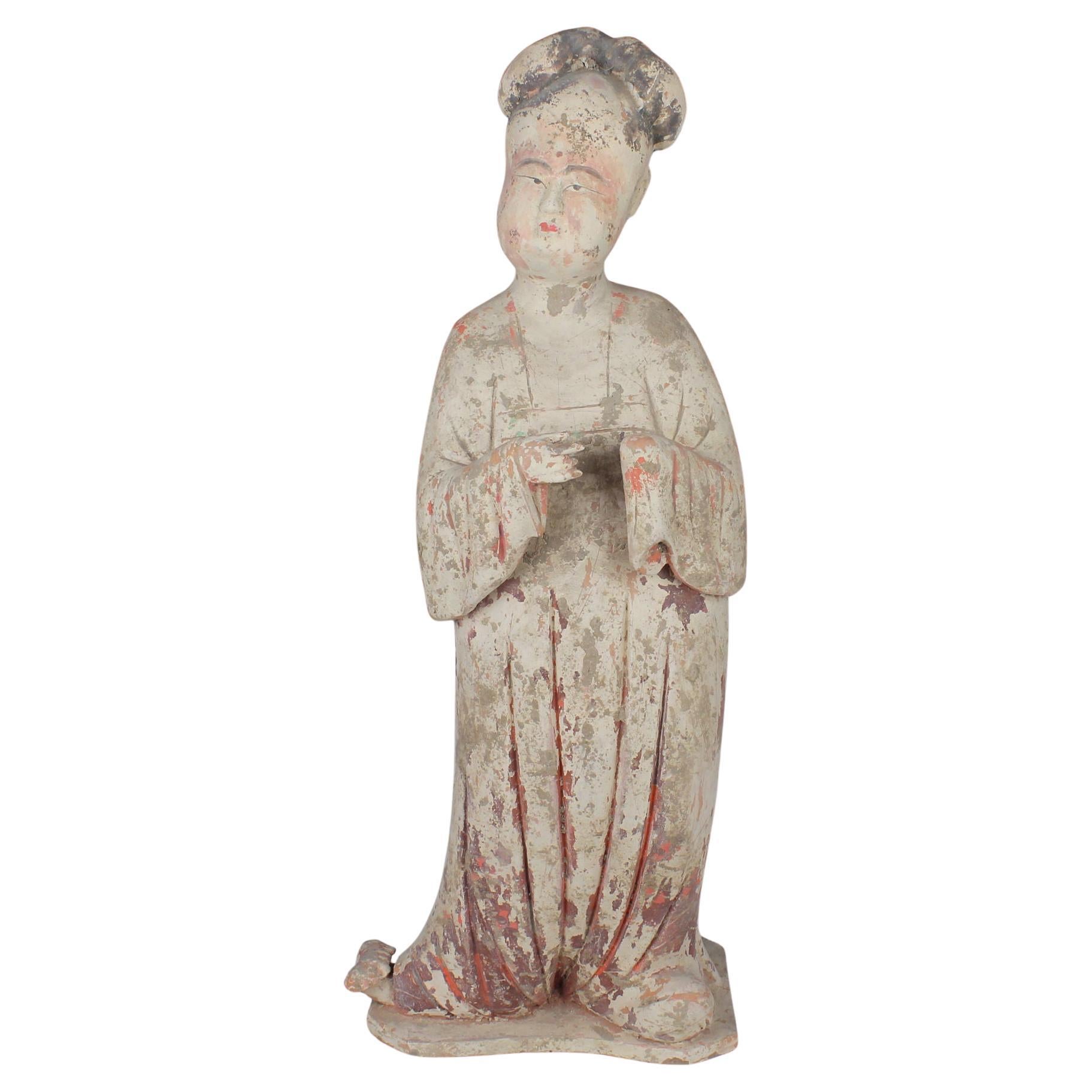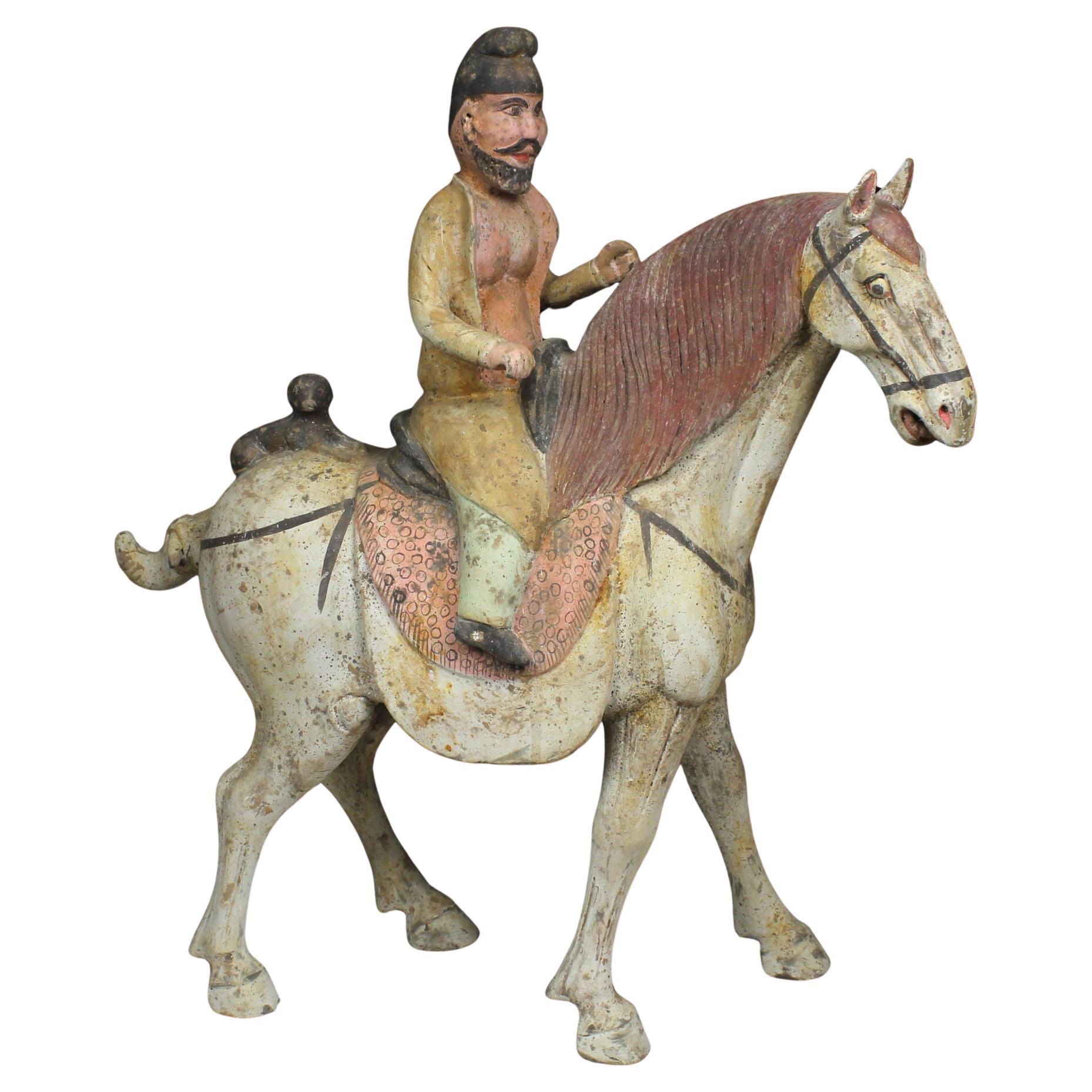Items Similar to Chinese statuette of a horse with musician
Want more images or videos?
Request additional images or videos from the seller
1 of 9
Chinese statuette of a horse with musician
About the Item
ITEM: Statuette of a horse with musician
MATERIAL: Pottery
CULTURE: Chinese, Tang Dynasty
PERIOD: 618 – 907 A.D
DIMENSIONS: 420 mm x 365 mm x 145 mm
CONDITION: Good condition. Includes Thermoluminescence test by Oxford Authentication (Sample C121m75)
PROVENANCE: Ex Belgian private collection (2022), Ex English art gallery, Ex English private collection, acquired from Hong Kong art market in 1990s
Comes with Certificate of Authenticity and Export Licence. If you are from outside the European Union, we will have to apply for the export licence again for your country, this takes 4 to 6 weeks.
Due to the fragility and size of this piece, it can only be shipped within the European Union, United Kingdom and neighbouring countries that can be transported by road by private courier (door to door).
The Tang Dynasty (618-907 AD) in China was a period marked by significant cultural development and artistic innovation. Among the various forms of artwork produced during this time, Minqi, or “folk art,” flourished as a reflection of everyday life and popular culture. One prominent type of Minqi art was the production of horse and musician statuettes. These figurines depicted scenes of entertainment and leisure, often featuring musicians playing instruments while mounted on horses.
The horse and musician statuettes of the Tang Dynasty exemplify the era’s fascination with both equestrianism and music. Horses held a central role in Tang society, symbolizing power, wealth, and nobility, while music was an integral part of social gatherings and ceremonies. The combination of these two elements in the statuettes reflects the dynastic period’s appreciation for leisure activities and the arts. These sculptures not only served as decorative items but also conveyed cultural values and ideals prevalent during the Tang era.
The craftsmanship of Tang Dynasty horse and musician statuettes was highly esteemed, with artisans showcasing their skill in sculpting intricate details and capturing dynamic poses. These figurines were crafted from various materials such as ceramic, pottery, and metal, demonstrating the versatility and creativity of Tang artisans.
唐朝(公元618年至907年)是中国历史上一个显著的文化发展和艺术创新时期。在这段时间里,民间艺术或“民器”繁荣发展,成为了日常生活和流行文化的反映。其中,一种著名的民器艺术形式就是制作马和音乐家塑像。这些塑像描绘了娱乐和休闲的场景,通常是以骑马的音乐家为特色,他们在马上演奏乐器。
唐代的马和音乐家塑像展示了当时对马术和音乐的迷恋。马在唐代社会中占据着核心地位,象征着权力、财富和贵族地位,而音乐是社交聚会和仪式的重要组成部分。这些塑像将马术和音乐两种元素结合起来,反映了这个时期对休闲活动和艺术的重视。这些雕塑不仅作为装饰品,而且传达了唐代时期普遍存在的文化价值观和理想。
唐代马和音乐家塑像的工艺被高度赞赏,艺术家们展示了他们在雕刻复杂细节和捕捉动态姿态方面的技艺。这些塑像由陶瓷、陶器和金属等各种材料制成,展示了唐代艺术家的多才多艺和创造力。如今,这些塑像作为珍贵的文物,为我们提供了关于唐代艺术成就、文化价值观和休闲娱乐活动的见解。
- Dimensions:Height: 16.54 in (42 cm)Width: 14.38 in (36.5 cm)Depth: 5.71 in (14.5 cm)
- Style:Tang (Of the Period)
- Materials and Techniques:
- Place of Origin:
- Period:
- Date of Manufacture:Tang Dynasty, 618 – 907 A.D
- Condition:Wear consistent with age and use.
- Seller Location:EL CAMPELLO, ES
- Reference Number:1stDibs: LU7382239036352
About the Seller
5.0
Vetted Seller
These experienced sellers undergo a comprehensive evaluation by our team of in-house experts.
Established in 2011
1stDibs seller since 2022
8 sales on 1stDibs
- ShippingRetrieving quote...Ships From: El Campello, Spain
- Return PolicyA return for this item may be initiated within 60 days of delivery.
More From This SellerView All
- Chinese statuette of a horseLocated in EL CAMPELLO, ESITEM: Statuette of a horse MATERIAL: Pottery CULTURE: Chinese, Northern Wei Dynasty PERIOD: 386 – 535 A.D DIMENSIONS: 404 mm x 350 mm x 230 mm CONDITION: Good condition. Includes Th...Category
Antique 15th Century and Earlier Chinese Tang Antiquities
MaterialsPottery
- Chinese statuette of a horseLocated in EL CAMPELLO, ESITEM: Statuette of a horse MATERIAL: Pottery CULTURE: Chinese, Tang Dynasty PERIOD: 618 – 907 A.D DIMENSIONS: 560 mm x 530 mm x 200 mm CONDITION: Good condition. Includes Thermolumin...Category
Antique 15th Century and Earlier Chinese Tang Antiquities
MaterialsPottery
- Chinese statuette of a horse with riderLocated in EL CAMPELLO, ESITEM: Statuette of a horse with rider MATERIAL: Pottery CULTURE: Chinese, Tang Dynasty PERIOD: 618 – 907 A.D DIMENSIONS: 520 mm x 420 mm x 180 mm CONDITION: Good condition. Includes ...Category
Antique 15th Century and Earlier Chinese Tang Antiquities
MaterialsPottery
- Chinese statuette of a Fat LadyLocated in EL CAMPELLO, ESITEM: Statuette of a Fat Lady MATERIAL: Pottery CULTURE: Chinese, Tang Dynasty PERIOD: 618 – 907 A.D DIMENSIONS: 655 mm x 265 mm x 210 mm CONDITION: Good condition. Includes Thermoluminescence test by Laboratory Kotalla (Reference 05B101123). Includes Certificate of Authenticity from Dutch gallery PROVENANCE: Ex Belgian private collection, acquired from Dutch art gallery Comes with Certificate of Authenticity and Export Licence. If you are from outside the European Union, we will have to apply for the export licence again for your country, this takes 4 to 6 weeks. Due to the fragility and size of this piece, it can only be shipped within the European Union, United Kingdom and neighbouring countries that can be transported by road by private courier (door to door). This beautifully-finished ceramic attendant was made during what many consider to be China’s Golden Age, the Tang Dynasty. It was at this point that China’s outstanding technological and aesthetic achievements opened to external influences, resulting in the introduction of numerous new forms of self-expression, coupled with internal innovation and considerable social freedom. The Tang dynasty also saw the birth of the printed novel, significant musical and theatrical heritage and many of China’s best- known painters and artists. The Tang Dynasty was created on the 18th of June, 618 AD, when the Li family seized power from the last crumbling remnants of the preceding Sui Dynasty. This political and regal regime was long-lived, and lasted for almost 300 years. The imperial aspirations of the preceding periods and early Tang leaders led to unprecedented wealth, resulting in considerable socioeconomic stability, the development of trade networks and vast urbanisation for China’s exploding population (estimated at around 50 million people in the 8th century AD). The Tang rulers took cues from earlier periods, maintaining many of their administrative structures and systems intact. Even when dynastic and governmental institutions withdrew from management of the empire towards the end of the period – their authority undermined by localised rebellions and regional governors known as jiedushi –the systems were so well- established that they continued to operate regardless. The artworks created during this era are among China’s greatest cultural achievements. It was the greatest age for Chinese poetry and painting, and sculpture also developed (although there was a notable decline in Buddhist sculptures following repression of the faith by pro-Taoism administrations later in the regime). It is disarming to note that the eventual decline of imperial power, followed by the official end of the dynasty on the 4th of June 907, hardly affected the great artistic turnover. During the Tang Dynasty, restrictions were placed on the number of objects that could be included in tombs, an amount determined by an individual’s social rank. In spite of the limitations, a striking variety of tomb furnishings – known as mingqi – have been excavated. Entire retinues of ceramic figures – representing warriors, animals, entertainers, musicians, guardians and every other necessary category of assistant – were buried with the dead in order to provide for the afterlife. Warriors (lokapala) were put in place to defend the dead, while horses/ camels were provided for transport, and officials to run his estate in the hereafter. Of all the various types of mingqi, however, there are none more elegant or charming than the sculptures of sophisticated female courtiers, known – rather unfairly – as “fat ladies...Category
Antique 15th Century and Earlier Chinese Tang Antiquities
MaterialsPottery
- Chinese statuette of a Fat LadyLocated in EL CAMPELLO, ESITEM: Statuette of a Fat Lady MATERIAL: Pottery CULTURE: Chinese, Tang Dynasty PERIOD: 618 – 907 A.D DIMENSIONS: 645 mm x 260 mm x 180 mm CONDITION: Good condition. Includes Thermoluminescence test by Laboratory Kotalla (Reference 04B101123). Includes Certificate of Authenticity from Dutch gallery PROVENANCE: Ex Belgian private collection, acquired from Dutch art gallery Comes with Certificate of Authenticity and Export Licence. If you are from outside the European Union, we will have to apply for the export licence again for your country, this takes 4 to 6 weeks. Due to the fragility and size of this piece, it can only be shipped within the European Union, United Kingdom and neighbouring countries that can be transported by road by private courier (door to door). This beautifully-finished ceramic attendant was made during what many consider to be China’s Golden Age, the Tang Dynasty. It was at this point that China’s outstanding technological and aesthetic achievements opened to external influences, resulting in the introduction of numerous new forms of self-expression, coupled with internal innovation and considerable social freedom. The Tang dynasty also saw the birth of the printed novel, significant musical and theatrical heritage and many of China’s best- known painters and artists. The Tang Dynasty was created on the 18th of June, 618 AD, when the Li family seized power from the last crumbling remnants of the preceding Sui Dynasty. This political and regal regime was long-lived, and lasted for almost 300 years. The imperial aspirations of the preceding periods and early Tang leaders led to unprecedented wealth, resulting in considerable socioeconomic stability, the development of trade networks and vast urbanisation for China’s exploding population (estimated at around 50 million people in the 8th century AD). The Tang rulers took cues from earlier periods, maintaining many of their administrative structures and systems intact. Even when dynastic and governmental institutions withdrew from management of the empire towards the end of the period – their authority undermined by localised rebellions and regional governors known as jiedushi –the systems were so well- established that they continued to operate regardless. The artworks created during this era are among China’s greatest cultural achievements. It was the greatest age for Chinese poetry and painting, and sculpture also developed (although there was a notable decline in Buddhist sculptures following repression of the faith by pro-Taoism administrations later in the regime). It is disarming to note that the eventual decline of imperial power, followed by the official end of the dynasty on the 4th of June 907, hardly affected the great artistic turnover. During the Tang Dynasty, restrictions were placed on the number of objects that could be included in tombs, an amount determined by an individual’s social rank. In spite of the limitations, a striking variety of tomb furnishings – known as mingqi – have been excavated. Entire retinues of ceramic figures – representing warriors, animals, entertainers, musicians, guardians and every other necessary category of assistant – were buried with the dead in order to provide for the afterlife. Warriors (lokapala) were put in place to defend the dead, while horses/ camels were provided for transport, and officials to run his estate in the hereafter. Of all the various types of mingqi, however, there are none more elegant or charming than the sculptures of sophisticated female courtiers, known – rather unfairly – as “fat ladies...Category
Antique 15th Century and Earlier Chinese Tang Antiquities
MaterialsPottery
- Chinese statuette of a Sogdian riderLocated in EL CAMPELLO, ESITEM: Statuette of a Sogdian rider MATERIAL: Pottery CULTURE: Chinese, Tang Dynasty PERIOD: 618 – 907 A.D DIMENSIONS: 560 mm x 510 mm x 175 mm CONDITION: Good condition. Includes The...Category
Antique 15th Century and Earlier Chinese Tang Antiquities
MaterialsPottery
You May Also Like
- Song Dynasty, A Pair of Antique Chinese Pottery Brick Tile with MusicianLocated in Sampantawong, THA pair of Chinese pottery brick tile with musician. Age: China, Song Dynasty, 10th - 12th Century Size: Height 30.2 - 30.8 C.M. / Width 18.3 - 19.2 C.M. Si...Category
Antique 15th Century and Earlier Chinese Antiquities
MaterialsPottery
- Chinese Tang Dynasty Sancai Glazed Horse and Rider, TL Tested, ChinaLocated in Austin, TXA fine and unusual Chinese Tang Sancai glazed model of a horse and rider, Tang Dynasty (618 to 906 CE), early 8th century, China. This fantastic sculpture portrays a male figures se...Category
Antique 15th Century and Earlier Chinese Tang Antiquities
MaterialsEarthenware, Pottery
- China 618-907 Ad Tang Dynasty Ancient Earthenware Sculpture of a Walking HorseLocated in Miami, FLStanding horse from the Tang Dynasty 618-907 AD. Beautiful sculptural piece of art from the Chinese ancient period of the Tang Dynasty (618-907 AD) featuring the finely sculptural figure of a horse, carefully made of earthenware clay pottery. The horse is standing in a very elegant and majestic position striding the four legs crossed. The animal has a slightly arched neck to the left looking forward and its extremely well modeled. The body is embellished with a beautiful saddle and intricate harnesses. The surface is treated with applications of natural color pigments such; white, light red and grays. Has a measurements of 343 mm by 140 mm by 356 mm (13.5 x 5.5 x14 Inches) (34.3 x 14 x 35.6 Cm). Tang dynasty or Tang Empire, was an imperial dynasty of China that ruled from 618 to 907, with an interregnum between 690 and 705. It was preceded by the Sui dynasty and followed by the Five Dynasties and Tend Kingdoms period. Historians generally regard the Tang as a high point in Chinese civilization, and a the golden age of cosmopolitan culture. Tang territory, acquired through the military campaigns of its early rulers, rivaled that of the Han dynasty. The Li family founded the dynasty, seizing power during the decline and collapse of the Sui Empire and inaugurating a period of progress and stability in the first half of the dynasty's rule. The dynasty was formally interrupted during 690–705 when Empress Wu Zetian seized the throne, proclaiming the Wu Zhou dynasty...Category
Antique 15th Century and Earlier Chinese Tang Antiquities
MaterialsEarthenware, Pottery
- Song Dynasty, Antique Chinese Painted Pottery Panel of Musician DrummerLocated in Sampantawong, THChinese painted pottery panel of musician drummer. Age: China, Song Dynasty, 10th - 12th Century Size: Height 27 C.M. / Width 14.1 C.M. Size including stand: Height 40.8 C.M. Condit...Category
Antique 15th Century and Earlier Chinese Antiquities
MaterialsPottery
- Song Dynasty, Antique Chinese Pottery Brick Tile with Musician Flute PlayerLocated in Sampantawong, THChinese pottery brick tile with musician flute player. Age: China, Song Dynasty, 10th - 12th Century Size of brick tile only: Height 31.6 C.M. / Width 18.8...Category
Antique 15th Century and Earlier Chinese Antiquities
MaterialsPottery
- Song Dynasty, Antique Chinese Pottery Brick Tile with Musician Flute PlayerLocated in Sampantawong, THAntique Chinese pottery brick tile with musician flute player. Age: China, Song Dynasty, 10th - 12th Century Size of brick tile only: Height 27 C.M. / Width 16.2 C.M. Height includi...Category
Antique 15th Century and Earlier Chinese Antiquities
MaterialsPottery
Recently Viewed
View AllMore Ways To Browse
Chinese Ceremony
Antique Hong
Dog Pottery Dynasty
Midcentury Modern Coffee Table And Side Tables
Vintage Modern Upholstered Chairs
Italian Chrome And Glass Tables
Italian Glass And Chrome Tables
Embassy Silver
Hand Painted Black Table
New Danish Dining Chairs
13 Vase
Built Ins
Vintage Corner Piece
Wood Chair Danish 1960s
Set Of Two Lights
Glass And Brass Vintage Pendant Light
Box On Feet
Vintage Table Set With Chairs
